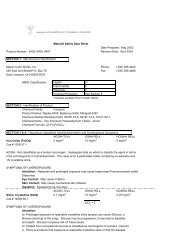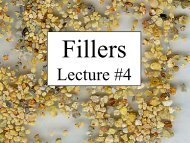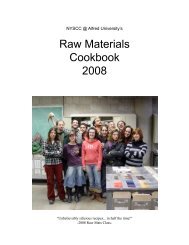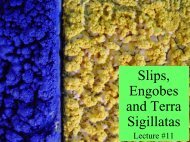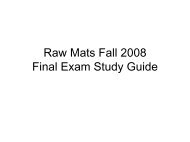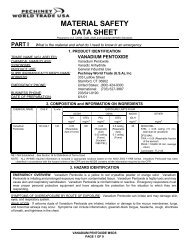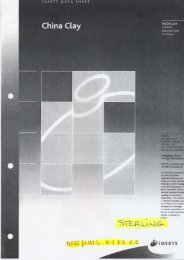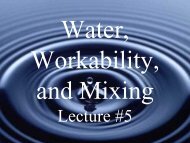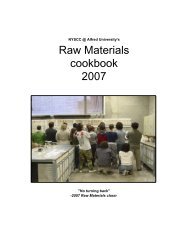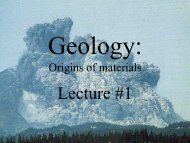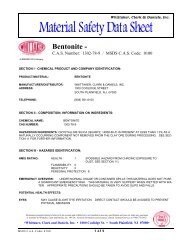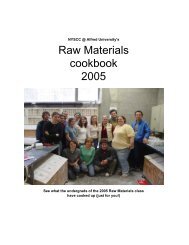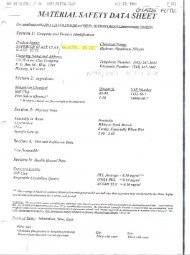Lecture #3 - Alfred's Clay Store
Lecture #3 - Alfred's Clay Store
Lecture #3 - Alfred's Clay Store
You also want an ePaper? Increase the reach of your titles
YUMPU automatically turns print PDFs into web optimized ePapers that Google loves.
Fluxes<br />
<strong>Lecture</strong> <strong>#3</strong>
Plastic<br />
<strong>Clay</strong>s<br />
Non-plastic<br />
Fluxes<br />
Fillers
In order to achieve a strong, dense clay<br />
body we rely on glass formation during<br />
firing…<br />
Silica - Is our main source of glass<br />
Forms glass by itself at 1710° C (32)<br />
Present in virtually all materials (clays, fluxes and<br />
fillers)<br />
Alkali – First 2 columns of the periodic table<br />
Reduce silica’s m.p.<br />
E.g. Na 2 O, Li 2 O 3 , K 2 O, CaO, MgO etc.<br />
Alumina - Controls viscosity of the glass<br />
Very refractory / raises m.p. / thickens the melt
Fluxes<br />
• The alkalis present in clay help account for<br />
the wide range of melting temperatures<br />
– <strong>Clay</strong>s with more alkalis tend to mature at lower<br />
temperatures<br />
• Alkalis are also found in many non-clay<br />
materials<br />
– Often in much higher concentrations than in<br />
clays<br />
– We refer to these classes of materials as<br />
“fluxes”
• Fluxes are oxides that promote fusion by<br />
interacting with other oxides in the presence<br />
of heat<br />
• Fluxes often contain varying amounts of<br />
SiO 2 and Al 2 O 3<br />
• Together, the amounts of silica and<br />
alumina, and the amounts and types of<br />
alkali determine the fired characteristics of<br />
fluxes. These include:<br />
– M.P. (melting point)<br />
– Firing range<br />
– CTE (coefficient of thermal expansion)
Roles of Flux in a <strong>Clay</strong> body<br />
• In clay bodies, fluxes promote<br />
– Glass Formation (Density)<br />
• Fluxes interact with and melt silica; without fluxes,<br />
clay bodies would need to be fired at much higher<br />
temperatures<br />
– Strength<br />
• As glass content increases, so does clay body<br />
strength<br />
– Fired shrinkage<br />
• As the amount of fluxing or melting increases,<br />
density increases and volume decreases
Flux additions in a body<br />
shrinkage<br />
absorption<br />
As flux amount increases, absorption decreases<br />
22.15<br />
22.97<br />
23.59<br />
23.14<br />
24.18<br />
23.44<br />
20.4<br />
17.15<br />
%<br />
14.48<br />
9.57<br />
As flux amount increases, shrinkage increases<br />
2 2<br />
1<br />
0.5<br />
1<br />
0.5<br />
1 1<br />
3<br />
4<br />
7<br />
1.49<br />
1 2 3 4 5 6 7 8 9 10 11<br />
% additions of frit in a body
• Glazes and clay bodies share similar oxides in<br />
their makeup<br />
– SiO 2 , Al 2 O 3 , Na 2 O, K 2 O, Li 2 O, CaO, MgO, Fe 2 O 3 + many others<br />
• One of the main compositional difference between<br />
glazes and bodies is in the amount of these oxides<br />
R 2 O<br />
Alkali<br />
RO<br />
weight % SiO 2 B 2 O 3 Al 2 O 3 Na 2 O K 2 O Li 2 O CaO MgO ZnO BaO SrO<br />
Glaze 51.00 0.00 13.44 1.09 5.43 0.00 10.26 0.06 6.51 0.00 0.00<br />
<strong>Clay</strong> body 54.70 0.00 29.62 1.67 1.43 0.00 0.64 1.96 0.00 0.00 0.00<br />
V.C. Satin White glaze ; V.C. Stoneware clay body (both cone 6)<br />
•Lower alkali levels in bodies than glazes
• <strong>Clay</strong> bodies contain more alumina than<br />
glazes<br />
– Al 2 O 3 stiffens / stabilizes melts (melts are more<br />
viscous/less runny)<br />
– Alumina makes clay bodies more refractory<br />
Note higher levels of alumina in clay body (3.13 SiO 2<br />
:1 Al 2<br />
O 3<br />
) compared with glaze<br />
Cone 6<br />
Glaze<br />
Cone 6<br />
<strong>Clay</strong> body<br />
SiO 2 B 2 O 3 Al 2 O 3 Na 2 O K 2 O Li 2 O CaO MgO ZnO BaO SrO Fe 2 O 3 TiO 2<br />
2.50 0.00 0.39 0.05 0.17 0.00 0.54 0.00 0.24 0.00 0.00 0.00 0.00<br />
SiO 2 +2B 2 O 3 / Al Ratio Alkali Metals Alkali Earth<br />
6.44 0.22 0.78<br />
SiO 2 B 2 O 3 Al 2 O 3 Na 2 O K 2 O Li 2 O CaO MgO ZnO BaO SrO Fe 2 O 3 TiO 2<br />
8.93 0.00 2.85 0.26 0.15 0.00 0.11 0.48 0.00 0.00 0.00 0.09 0.15<br />
SiO 2 +2B 2 O 3 / Al Ratio Alkali Metals Alkali Earth<br />
3.13 0.41 0.59<br />
Alkalis normalized to 1<br />
• Together, Alkali and silica/alumina levels help determine the<br />
quantity, viscosity, and melting point of glass
SiO 2 B 2 O 3 Al 2 O 3 Li 2 O Na 2 O K 2 O CaO MgO SrO BaO ZnO<br />
SiO 2 +2B 2 O 3 / Al Ratio Alkali Metals Alkali Earth<br />
+1
SiO 2 B 2 O 3 Al 2 O 3 Li 2 O Na 2 O K 2 O CaO MgO SrO BaO ZnO<br />
SiO 2 +2B 2 O 3 / Al Ratio Alkali Metals Alkali Earth<br />
+2
Of the Alkali, which tend to be stronger fluxes<br />
SiO 2 B 2 O 3 Al 2 O 3 Li 2 O Na 2 O K 2 O CaO MgO SrO BaO ZnO<br />
SiO 2 +2B 2 O 3 / Al Ratio Alkali Metals Alkali Earth<br />
+1<br />
+1<br />
-2 -2<br />
+2<br />
oxygen<br />
–Metals R 2 O (Two elements per oxygen)<br />
–Earths RO (One element per oxygen)<br />
• Alkali Metals tend to be stronger fluxes than Alkali Earths<br />
– Alkali Metals are more easily separated from their bond with<br />
oxygen (each element only has a +1 bond with oxygen)<br />
– The +2 bond of the Alkali Earths requires much more energy to<br />
break down
• The alkalis’ strength as fluxes does not<br />
always correlate with their m.p. (melting<br />
point)<br />
– I.e. Zinc melts earlier than Calcium, yet it is a<br />
weaker flux
Eutectic<br />
A proportioned mixture of two or more materials,<br />
which melts at the lowest possible temperature<br />
Liquid<br />
Solid<br />
Solid<br />
E.g. An RO (e.g. MgO, CaO, ZnO) and SiO 2 form a<br />
eutectic when mixed 60/40.
A eutectic<br />
More melting occurs in the middle<br />
of the blend than at either end<br />
100% Glaze<br />
100% Spodumene
Some combinations of materials can have multiple Eutectics; if the<br />
gaps in your line blend are too large, you may miss out on these…<br />
E.g. PbO & CuO
The SiO 2 -Al 2 O 3 eutectic
Phase Diagrams<br />
Typical Industrial<br />
Porcelain Compositions<br />
Phase Diagrams depict the<br />
various different liquid,<br />
solid and mixed phases of<br />
mineral mixtures at various<br />
different temperatures.<br />
SiO 2<br />
K 2 O<br />
Al 2 O 3<br />
Introduced through<br />
different raw<br />
materials
CTE…<br />
@ High T<br />
On Cooling<br />
CTEGCTEB<br />
Glaze in Compression Glaze in Tension<br />
Coefficient<br />
of<br />
Thermal<br />
Expansion<br />
body<br />
glaze<br />
body glaze body glaze<br />
A change in volume<br />
based on temperature<br />
(Low CTE glaze/<br />
High CTE body)<br />
Shiver<br />
(High CTE glaze/<br />
Low CTE body)<br />
Craze<br />
• Everything we put into a body will affect its overall CTE<br />
• Fluxes/materials that exhibit very low or very high CTE<br />
may limit the use of some glazes (or at the very least,<br />
glazes may not “fit” properly)
All oxides have<br />
a specific<br />
Coefficient<br />
of Thermal<br />
Expansion<br />
(CTE)<br />
We will revisit<br />
this later…
High Metals High Earths<br />
Classification Of Fluxes<br />
• Feldspar<br />
• Frit<br />
• Talc<br />
• Whiting<br />
• Bone Ash<br />
• Dolomite<br />
• Wollastonite<br />
Primary<br />
Secondary<br />
Strong / stable enough<br />
to be used alone<br />
Used in combination with<br />
primary fluxes<br />
–Primary fluxes are higher in R 2 O (metals) (talc is an exception)<br />
–Secondary fluxes are higher in RO (earths)
Feldspars<br />
<strong>Clay</strong> Al 2 O 3 •2SiO 2 •2H 2 O<br />
Potassium spar K 2 O•Al 2 O 3 •6SiO 2<br />
Soda spar Na 2 O•Al 2 O 3 •6SiO 2<br />
Lithium spar Li 2 O•Al 2 O 3 •4,8SiO 2<br />
• Feldspars involve alkali (Na 2 O, K 2 O, Li 2 O, CaO, MgO )<br />
with alumina and silica<br />
• They are the most common flux above 6<br />
• Will form a glass alone at high temperatures<br />
• In general, provide fluxing action over a long firing range<br />
• Forgiving if over/under fired<br />
• Inexpensive ($0.12/lb. vs. $0.80/lb. for frits)
Feldspars<br />
Metals<br />
Earths<br />
Al 2 O 3 • 2SiO 2 •2H 2 O<br />
K 2 O•3Na 2 O•4Al 2 O 3 •9SiO 2<br />
Na 2 O•Al 2 O 3 •6SiO 2<br />
K 2 O•Al 2 O 3 •6SiO 2<br />
<strong>Clay</strong>s<br />
Soda<br />
Spars<br />
Potash<br />
Spars<br />
SiO 2 Al 2 O 3 Na 2 O K 2 O Li 2 O CaO MgO Fe 2 O 3<br />
EPK 43.44 35.46 0.40 0.05 0.16 0.51<br />
Redart 54.30 16.40 0.40 4.07 0.23 1.55 7.04<br />
Neph Sy 61.95 22.10 10.29 4.40 0.36 0.03 0.04<br />
Kona F-4 68.50 18.56 6.22 4.61 1.45 0.01 0.07<br />
NC-4<br />
Custer 69.60 16.24 2.10 10.33 0.32 0.08 0.26<br />
G-200 75.03 12.79 3.65 7.31<br />
Cornwall 74.73 14.28 2.95 3.72 1.47 0.11 0.20<br />
• Much higher alkalis than clays<br />
• Higher silica than clays (6SiO 2 vs. 2SiO 2 )<br />
• Usually contain multiple alkalis (classification is<br />
based on predominance of Na or K)<br />
– I.e. Soda Spars always contain some Potash and vice versa
Soda Spars<br />
Na 2 O•Al 2 O 3 •6SiO 2<br />
•More powerful and melt earlier than potash spars because<br />
soda is more reactive (Neph Sy. is lowest melting of all spars)<br />
•Begin to melt at 4 (potash begins at 6)<br />
•Shorter firing range than potash spars<br />
•Soda is more soluble than potash and acts as a deflocculant<br />
•Can deflocculate clay bodies (decrease plasticity)<br />
•Bodies that contain high concentrations of Neph Sy. can<br />
shorten over time
Potash Spars<br />
K 2 O•Al 2 O 3 •6SiO 2<br />
• Potash volatilizes latter in the firing than soda<br />
– more stable at higher temperatures<br />
• Wider firing range than soda<br />
• Dissolves silica more easily than soda spar<br />
– Can improve translucency in porcelains<br />
• Cornwall Stone<br />
– Transitional material between feldspar and kaolin<br />
– Relatively plastic compared to other feldspars but dirtier
10 R.<br />
10 Ox.<br />
N/A<br />
6<br />
04<br />
Custer G-200 PV clay Cornwall<br />
Stone<br />
Kona F-4 NC-4 Minspar<br />
Neph Sy<br />
Potash<br />
Soda
Custer Kona F-4<br />
@ C. 6<br />
Note: Single<br />
material samples<br />
like these do not<br />
account for<br />
eutectics!<br />
Neph Sy
• High Temperatures<br />
– Porcelain<br />
Feldspars In Bodies<br />
• High percentages are used to create dense, glassy bodies<br />
• Normally 10-30% additions<br />
– Stoneware<br />
• Normally up to 10% additions (often less dense than<br />
porcelains)<br />
• Stoneware bodies get higher amounts of alkalis from dirty<br />
clays than porcelains do (and therefore require less flux)<br />
• Mid Temperatures<br />
• Often used in combination with lower temperature fluxes<br />
(I.e. frits, talc etc.)
• A purification process in which<br />
a mineral is coated with a<br />
specific organic compound<br />
• The compound is hydrophobic<br />
(doesn't like water)<br />
• The organic compound (and the<br />
targeted mineral) attaches itself<br />
to air bubbles that rise; they are<br />
removed at the surface<br />
• Uncoated minerals sink to the<br />
bottom and are reprocessed with<br />
different compounds<br />
Froth Floatation:<br />
Differentiation revisited<br />
•Chronology of purification for a feldspar: Mica, Iron, Feldspar and Silica
Lithium Feldspars<br />
Petalite Li 2 O•Al 2 O 3 •8SiO 2<br />
Spodumene Li 2 O•Al 2 O 3 •4SiO 2<br />
• Contain high levels of lithia along with trace<br />
amounts of the other alkalis<br />
• Exhibit very low CTE because of lithia<br />
• Increase resistance to thermal shock<br />
• Ideal for oven ware and flame ware<br />
• When used alone, require large amounts<br />
– Displace clay in the recipe / this reduces plasticity<br />
• More expensive than other fluxes<br />
– Usually only used for flame ware / ovenware bodies
Petalite<br />
Li 2 O•Al 2 O 3 •8SiO 2<br />
• Petalite<br />
– Lowest CTE (coefficient of thermal expansion)<br />
of all lithium spars<br />
• Increases resistance to thermal shock<br />
– High temperature flux ( 9-14)<br />
– Short firing range<br />
– A powerful auxiliary flux in combination with<br />
soda / potash spars, talc or whiting<br />
– Used in flame ware bodies (in combination<br />
with spodumene – up to 60%)
Spodumene<br />
Li 2 O•Al 2 O 3 •4SiO 2<br />
• Spodumene<br />
– Dirtier source of lithia (Li) than petalite<br />
• Can contain up to 2.5% Fe<br />
– More refractory than Petalite (more Al 2 O 3 )<br />
• M.p. of 14-15 (Petalite m.p. 11-12)<br />
• Contains only 5-8% alkali (most other spars >12%)<br />
– Very low CTE, but still five times higher than<br />
petalite<br />
– Gives warm orange-brown color to low iron<br />
stoneware bodies<br />
– Is expensive (usually only used for flame ware)
C.10 re.<br />
C.10 ox.<br />
C.6<br />
C.04<br />
Petalite<br />
Spodumene
MgO•4SiO 2 •H 2 O<br />
Talc<br />
• A.K.A. Magnesium Silicate<br />
• Common low-temperature material<br />
– Begins interacting/decomposing at 09<br />
– Melts at 12<br />
– Also used at higher temperatures but not as common as<br />
feldspars or frits<br />
• Readily forms eutectics with other materials<br />
100% Stoneware body Stoneware body + Talc
Talc<br />
• Encourages formation of the mineral Cordierite at high<br />
temperatures Cordierite (has low CTE; like lithium<br />
bodies, talc bodies are used for thermal shock-proof<br />
situations)<br />
• Ovenware / flame ware<br />
• yellowish kiln shelves are made of Cordierite<br />
• Promotes fired whiteness (Talc is low in Fe)<br />
– Actually, not in Alfred anymore<br />
• We now use a dirtier Talc… the really clean stuff potentially<br />
contained asbestos-like minerals<br />
• Inexpensive to use compared to frits<br />
• Longer firing range than frits<br />
• Some talc contains carbonates<br />
– May cause bloating if fired too quickly
Talc<br />
• Large amounts are used at low temperatures (unless<br />
other fluxes are present)<br />
– Large amount of talc limits clay content in clay body<br />
Decrease in clay = decrease in plasticity<br />
– Hi Talc bodies are therefore relatively non-plastic and are<br />
best suited for casting or other situations where little<br />
plasticity is needed<br />
• At low temperatures produces Enstatite<br />
– Enstatite has a high CTE (can help prevent crazing)<br />
– Controls moisture expansion in non-vitreous bodies (which<br />
can also prevent delayed crazing)<br />
– But may lead to cooling cracks (not great for Raku)
Talc In Bodies<br />
• High Temperatures<br />
– Used for shock-proof bodies at very high<br />
temperatures (w/high amounts of talc)<br />
– Powerful auxiliary flux for high-fire bodies (3-5%<br />
addition)<br />
• Mid Temperatures<br />
– 2-5% addition with Feldspar produces lower firing<br />
range and tighter, stronger body (eutectic)<br />
– Can lower maturing temp by 2-3 cones, or from<br />
high-fire to mid-fire<br />
– 40-50% required to flux to vitreous state (e.g. 50% talc 50%<br />
ball clay is vitreous at cone 6)<br />
• Low Temperatures<br />
• Extensively use, probably functions as a filler (definitely<br />
not vitreous when used alone!)<br />
• Varying amounts used (up to 50%), along with other fluxes
Frit<br />
• The main low temperature flux<br />
• Pre-fired glass made from several different materials<br />
• Melt at lower temperatures 017-02<br />
– energy has gone into melting them<br />
– Silica and alkali have combined to form glass<br />
– less energy/heat required to melt again<br />
• Frits are very expensive because of their preparation<br />
• Much narrower melting range and quicker melting<br />
than feldspars (lower alumina levels)<br />
– A 2 cone difference in a firing can have drastic effects<br />
• Used at mid and sometimes high temperatures but in<br />
smaller amounts
SiO2 Al2O3 Na2O K2O Li 2 O CaO MgO Fe 2 O 3 B 2 O 3<br />
EPK 43.44 35.46 0.4 0.05 0.16 0.51<br />
Kona F-4 68.5 18.56 6.22 4.61 1.45 0.01 0.07<br />
Custer 69.6 16.24 2.1 10.33 0.32 0.08 0.26<br />
Frits<br />
3110 69.43 3.93 15.52 2.18 6.26 2.68 2.59<br />
3124 55.31 9.90 6.24 0.68 14.11 13.77<br />
3134 47.42 10.32 21.94 20.32<br />
3195 58.70 10.87 6.52 15.22 8.70<br />
• Frits introduce higher amounts of soda and<br />
calcium than feldspars<br />
• Frits also introduce boron<br />
– Boron plays an important role in lowering the melt<br />
temperature (boric oxide m.p. 017)<br />
– Boron acts as both a flux and glass former<br />
• Lower amounts of alumina gives more fluid<br />
melts compared to feldspars
Frits<br />
• Like soda feldspars, hi Na frits can be soluble<br />
in water (aged clay can loose plasticity)<br />
• The most common body frits are 3124 and 3195<br />
– 3110 has lower boron content (less slumping)<br />
– 3124 has less soda (may not deflocculate over time<br />
as much = better plasticity)
C.10 re.<br />
C.10 ox.<br />
C.6<br />
C.04<br />
3124 3195<br />
3110
Frits In Bodies<br />
• High Temperatures<br />
– Rarely used (feldspars are less expensive/more<br />
forgiving)<br />
• Mid Temperatures<br />
– Often used in small amounts (up to 12%) in<br />
combination with feldspars and/or talc<br />
• Low Temperatures<br />
• Extensively use as a primary flux (up to 30%)<br />
• Also used in smaller amounts when talc or<br />
wollastonite are present
Secondary Fluxes<br />
• Secondary fluxes are low in alkali metals<br />
(Na, K, Li) and hi in earths (Ca, Mg +<br />
others)<br />
• Often more refractory, and less active<br />
• Used in combination with primary fluxes
Bone Ash<br />
3CaO•P 2 O 5<br />
• A.K.A. Calcium Phosphate<br />
• Melts alone at 33<br />
• Contains 55% calcium and 40% phosphorous<br />
pentoxide<br />
– (Like SiO 2 )P 2 O 5 is a glass former<br />
– Unlike SiO 2 ,P 2 O 5 vitrifies with little softening or slumping<br />
– Very high viscosity melt<br />
• Usually made from calcined cattle bones<br />
• Small carbon content (1%) after calcination may add<br />
some plasticity<br />
– However, is still non-plastic compared to clay<br />
– Often used in casting bodies / non-plastic forming
Bone Ash<br />
3CaO•P 2 O 5<br />
• At High Temperatures<br />
– Extensively used (up to 50%) in bone china for<br />
its anti slump properties, whiteness, and added<br />
translucency<br />
– Increases fluxing of feldspars in smaller<br />
amounts (due to Ca)<br />
• At Mid Temperatures and below<br />
– Ineffective as a flux
Whiting<br />
CaCO 3<br />
• Generally used as a secondary flux<br />
• Soluble in water (migrates to surfaces during drying)<br />
• High Temperature<br />
– Very powerful flux<br />
• Difficult to control<br />
• Small additions (1-2%) can improve translucency (Ca may enhance<br />
translucency)<br />
• Small additions may also reduce the need for feldspar<br />
Ex: Cone 10 50% <strong>Clay</strong><br />
50% <strong>Clay</strong><br />
30% Spar<br />
20% Flint<br />
=<br />
20% Spar<br />
20% Flint<br />
+ 2% whiting<br />
8% more<br />
clay can be<br />
added
Whiting<br />
CaCO 3<br />
• Mid Temperatures<br />
– Useful in this range as a secondary flux<br />
• Low Temperatures<br />
– Prevents warping and increases whiteness of<br />
fired bodies<br />
– But does not flux<br />
– If not well mixed, larger clumps can absorb<br />
moisture after firing, swell and cause pop-outs
Wollastonite<br />
CaSiO 3<br />
• Considered a flux and a filler<br />
• As a flux<br />
– Ca as a silicate is very stable – no chance of CaO<br />
hydration, or lime popping (unlike CaCO 3 )<br />
– Insoluble compared to CaCO 3<br />
• Improves fired strength<br />
• Improves thermal shock resistance<br />
• High aspect ratio (fibrous) needlelike crystals<br />
provide high fired strength
Wollastonite’s needle-like crystals within a silica melt
Wollastonite<br />
CaSiO 3<br />
• However<br />
– Limited to fluxing at high temperatures (Ca<br />
present)<br />
– Slightly higher m.p. than CaCO 3<br />
• As A Filler<br />
– Reduces drying shrinkage<br />
– Needle shaped crystals increase green strength
Deciding on Flux amounts…<br />
White Translucent<br />
50% <strong>Clay</strong><br />
50% Flux/Flint<br />
Off white to dark<br />
80% <strong>Clay</strong><br />
20% Flux/Flint<br />
• White clays are refractory<br />
• Require large amounts of<br />
flux and silica to create<br />
glass<br />
• Not very plastic (50% clay)<br />
• Darker clays naturally contain<br />
some flux<br />
• Require smaller amounts of flux<br />
and silica to create glass<br />
• Much more plastic (80% clay)
Deciding on Flux types…<br />
• High Temps<br />
– Feldspars<br />
• Mid Temps<br />
– Feldspars<br />
– Talc<br />
– Frits<br />
• Low Temp<br />
– Frits<br />
– Talc
References<br />
Ceramic Industry<br />
(Periodical)<br />
Business News Publishing Co, Troy, MI<br />
January 2002<br />
Ceramic Science for the Potter<br />
W. G. Lawrence<br />
Chilton Book Company, Philadelphia, New York, London<br />
First Edition, 1972<br />
<strong>Clay</strong> Mineralogy<br />
by Ralph E. Grim<br />
McGraw-Hill Book Company, New York, St. Louis, San Francisco<br />
Second Edition, 1968<br />
<strong>Clay</strong>s and Ceramic Raw Materials<br />
by W. E. Worrall<br />
Elsevier Applied Science Publishers, London and New York<br />
Second Edition, 1986
References<br />
Cushing’s Handbook<br />
by Val Cushing<br />
Third Edition, 1994<br />
Science of Whitewares II<br />
edited by William M. Carty and Christopher W. Sinton<br />
The American Ceramic Society, Westerville, OH<br />
2000<br />
The Potter’s Alternative<br />
By Harry Davis<br />
Methuen Australia Pty Ltd, North Ryde, NSW<br />
First Edition, 1987<br />
The Potter’s Dictionary of Materials and Techniques<br />
by Frank and Janet Hamer<br />
A&C Black Publishers Ltd., London, England<br />
Third Edition, 1993



